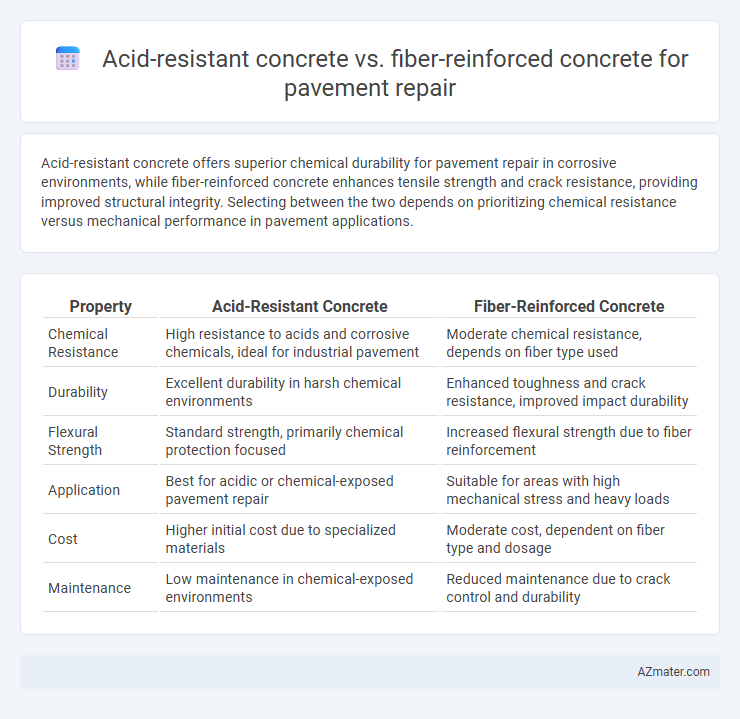Acid-resistant concrete offers superior chemical durability for pavement repair in corrosive environments, while fiber-reinforced concrete enhances tensile strength and crack resistance, providing improved structural integrity. Selecting between the two depends on prioritizing chemical resistance versus mechanical performance in pavement applications.
Table of Comparison
| Property | Acid-Resistant Concrete | Fiber-Reinforced Concrete |
|---|---|---|
| Chemical Resistance | High resistance to acids and corrosive chemicals, ideal for industrial pavement | Moderate chemical resistance, depends on fiber type used |
| Durability | Excellent durability in harsh chemical environments | Enhanced toughness and crack resistance, improved impact durability |
| Flexural Strength | Standard strength, primarily chemical protection focused | Increased flexural strength due to fiber reinforcement |
| Application | Best for acidic or chemical-exposed pavement repair | Suitable for areas with high mechanical stress and heavy loads |
| Cost | Higher initial cost due to specialized materials | Moderate cost, dependent on fiber type and dosage |
| Maintenance | Low maintenance in chemical-exposed environments | Reduced maintenance due to crack control and durability |
Overview of Specialized Concrete Types for Pavement Repair
Acid-resistant concrete incorporates chemical additives and specific aggregates to withstand corrosive environments, making it ideal for pavement repair in industrial areas exposed to acidic substances. Fiber-reinforced concrete integrates synthetic or steel fibers to enhance tensile strength, crack resistance, and durability for pavements subjected to heavy traffic and dynamic loads. Both specialized concrete types improve pavement lifespan by addressing distinct environmental and mechanical stressors through tailored material properties.
Key Properties of Acid-Resistant Concrete
Acid-resistant concrete features high chemical durability due to its low permeability and dense microstructure, which effectively withstands corrosive environments commonly encountered in industrial pavements. Its composition typically includes silica fume, acid-resistant aggregates, and specialized cementitious materials that enhance resistance to sulfuric and hydrochloric acids. This concrete's superior resistance to chemical attack, combined with adequate compressive strength and abrasion resistance, makes it ideal for pavement repairs subjected to acidic conditions.
Essential Characteristics of Fiber-Reinforced Concrete
Fiber-reinforced concrete (FRC) for pavement repair is characterized by enhanced tensile strength, improved crack resistance, and increased durability compared to conventional mixes. Its essential characteristics include the incorporation of synthetic or steel fibers that distribute loads more evenly and reduce shrinkage-induced fractures. Unlike acid-resistant concrete, which prioritizes chemical durability against corrosive environments, FRC excels in mechanical performance and is particularly effective in extending pavement service life through better impact and fatigue resistance.
Durability Under Chemical Exposure: Comparison
Acid-resistant concrete exhibits superior durability under chemical exposure by incorporating acid-resistant aggregates and special cementitious materials that prevent degradation from acidic environments. Fiber-reinforced concrete enhances mechanical properties and crack resistance but may not provide the same level of chemical resistance unless combined with acid-resistant components. For pavement repair in chemically aggressive settings, acid-resistant concrete offers a longer service life by effectively resisting acid attack, while fiber reinforcement primarily improves structural integrity rather than chemical durability.
Mechanical Strength and Flexural Performance
Acid-resistant concrete exhibits superior chemical durability and mechanical strength, making it ideal for pavement repair in corrosive environments, while fiber-reinforced concrete offers enhanced flexural performance and crack resistance due to the distribution of fibers within the matrix. Mechanical strength in acid-resistant concrete resists degradation from acidic exposure, whereas fiber-reinforced concrete improves toughness and flexibility under dynamic loads. Selecting between the two depends on the specific pavement conditions, with acid-resistant concrete favored for chemical resistance and fiber-reinforced concrete optimized for structural resilience and flexural behavior.
Installation Methods and Construction Time
Acid-resistant concrete for pavement repair requires meticulous surface preparation and often involves the application of protective coatings to ensure chemical durability, which can extend installation time. Fiber-reinforced concrete simplifies installation by enhancing workability and reducing the need for steel reinforcement, leading to faster curing and shorter overall construction time. Choosing fiber-reinforced concrete typically accelerates project completion, whereas acid-resistant concrete demands careful layering and curing protocols to maintain its chemical protection properties.
Cost Analysis: Materials and Long-Term Maintenance
Acid-resistant concrete typically incurs higher initial costs due to specialized chemical additives and higher-grade cement materials designed to withstand corrosive environments. Fiber-reinforced concrete often offers a more cost-effective solution with enhanced tensile strength and crack resistance, reducing the frequency and extent of repairs. Long-term maintenance expenses tend to be lower for fiber-reinforced concrete, as its durability minimizes structural degradation, unlike acid-resistant concrete which may require periodic surface treatments to maintain resistance.
Suitability for Different Pavement Environments
Acid-resistant concrete excels in environments exposed to chemical corrosion, particularly in industrial or wastewater treatment areas, due to its enhanced resistance to acidic substances. Fiber-reinforced concrete is more suitable for high-traffic pavements where mechanical strength and crack control are critical, offering superior durability under heavy loads and thermal stresses. Selecting the appropriate concrete type depends on environmental exposure: acid-resistant concrete for chemically aggressive conditions and fiber-reinforced concrete for structural integrity in robust pavement applications.
Sustainability and Environmental Impact
Acid-resistant concrete provides enhanced durability in environments exposed to chemical attacks, reducing the frequency of repairs and associated resource consumption, thus contributing positively to sustainability. Fiber-reinforced concrete improves crack resistance and extends pavement lifespan, decreasing maintenance needs and minimizing environmental impact through reduced material waste. Selecting the appropriate concrete type for pavement repair promotes sustainable infrastructure by balancing longevity, reduced resource use, and lower carbon footprint.
Choosing the Right Concrete for Pavement Repair Applications
Acid-resistant concrete offers superior durability and chemical resistance in environments exposed to acidic substances, making it ideal for industrial pavement repairs where chemical exposure is frequent. Fiber-reinforced concrete enhances tensile strength and crack resistance, improving the pavement's overall durability and flexibility under heavy traffic loads and temperature variations. Selecting the right concrete depends on specific site conditions such as chemical exposure levels and structural stress, ensuring optimal longevity and performance in pavement repair applications.

Infographic: Acid-resistant concrete vs Fiber-reinforced concrete for Pavement repair
 azmater.com
azmater.com